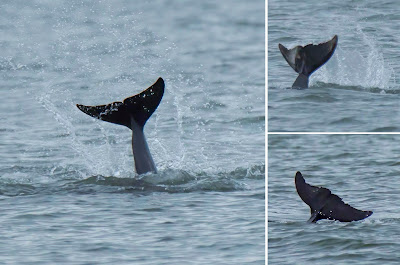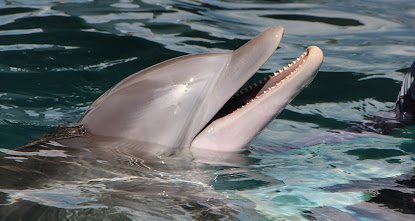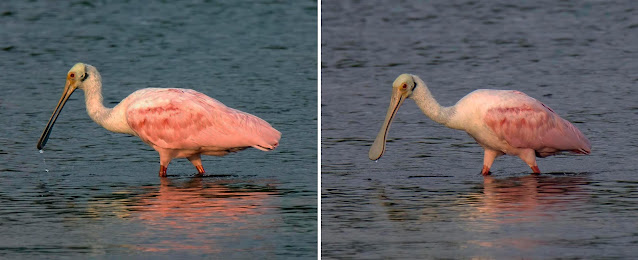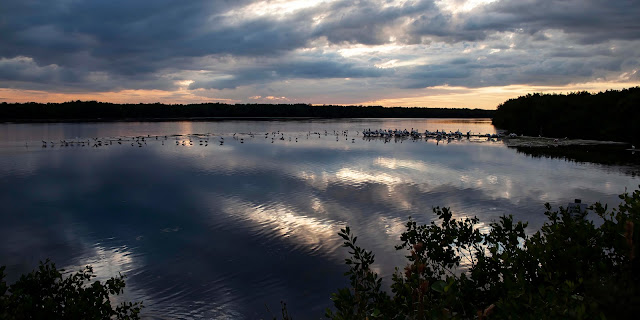 |
| D.N. "Ding" Darling National Wildlife Refuge, Sanibel Island, Florida |
I am not going to cover the reunion in my blog.
(Do you really want to know who was there and who did what? I didn't think so).
Plus, this blog is pretty much dedicated to travel and wildlife, so my reunion is a bit off-brand. But, I will mention a few things:
 |
| Hangin' with friends |
It is a wonderful experience to reconnect with people from your youth.
I like the people I grew up with and I like the person I have become.
It is amazing how recent 50 years can seem (of course it helped that I spent weeks putting together the reunion slideshow before I went).
As my daughter once said, growing up in Florida has some reunion advantages: you get to travel to a place worth visiting on its own.
I took the opportunity of traveling to Florida to return to a place I have birded before – Sanibel Island ...
 |
| Great Egrets and a juvenile White Ibis at Ding Darling NWR on Sanibel Island |
 |
| My two destinations |
Oscar Scherer State Park
Let’s start with Oscar Scherer. The goal was to see a Florida Scrub-Jay, the one U.S. Scrub-Jay that I have not seen (and I grew up in Florida!).
 |
| I have seen the Island, California and Woodhouse's Scrub-Jay, just not the Florida |
Unfortunately, it was not to be. I actually went to the Park twice – once on my way to Sanibel and once on my way back. As is to be expected in Florida, day one was brutally hot and humid and one day was cool and breezy.
 |
| A steamy Florida terrain; Photo; StateParks.com |
The first (very hot) day, I hiked and hiked, seeing one bird that might have been a Florida Scrub-Jay, but it moved too fast and flew into a dense bush, making it impossible to capture with my camera.
The second visit was delightful weather, but fewer birds. I did meet a woman who said she had just seen one. But, all I saw were Blue Jays that aggravated me so much that I didn’t shoot them. I did capture a few Northern Mockingbirds ...
 |
| A nice pose from a familiar bird |
... and Red-bellied Woodpeckers ...
 |
| Hard at work looking for seeds and bugs |
But, that was about it.
Between Sarasota and Venice near Osprey, Florida, Oscar Scherer State Park was once a 462-acre ranch owned by Elsa Scherer Burrows. When she died in 1955, she left the ranch to the state to form a Park.
Opened that same year, the Park was dedicated to the memory of Elsa's industrialist father, Oscar.
Thirty years later, realtor and environmentalist Jon Thaxton added another 922 acres to protect the neighboring Florida Scrub-Jay territory.
 |
| Scrub Jays like the pine flats and hammocks; Photo: AllTrails |
In 2008, in recognition of National Public Lands Day, Lee Wetherington, a local developer and long-time Park supporter, donated an additional 16.6 acres, bringing the total park size to 1,400 acres.
The Park comprises pine and scrubby flatwoods and a hardwood hammock surrounding South Creek.
 |
| A Park trail; Photo: Great Runs |
Critters include Bobcats, Rabbits, Foxes, River Otters, Alligators, Snakes, Gopher Tortoises, Frogs, Bald Eagles, Ospreys, Warblers, Woodpeckers, Egrets and Great Blue and Little Blue Herons.
But, not so much during my visits.
 |
| Butterflies were profuse, mainly Common Buckeyes |
Oddly, I didn’t photograph the area at all. I guess I was too intent on the illusive Florida Scrub-Jay.
 |
| Unfortunately, not my shot; Photo: Florida Ambler |
Maybe next time.
Sanibel Island
I had better luck with birds in Sanibel ...
 |
| A momentarily bird-free beach |
... primarily at J. N. "Ding" Darling National Wildlife Refuge, where I spent most of my brief stay there.
 |
| Offshore Dolphins |
I stayed at the Sunset Beach Inn, but didn’t spend a lot of time there, except for a morning walk, where I witnessed the antics of a rather frisky group of Atlantic Bottlenose Dolphins.
With no restaurant onsite, I brought stone crab claws back to my room. Yum!
Sanibel is both an island and a city in Lee County, Florida, just west of Fort Myers. It is a sandy barrier island on the leeward side of the more solid coral-rock of Pine Island.
 |
| Photo: Sanibel-Captiva.org |
 |
| Map: Backroads Travel |
More than half of the island is wildlife refuge, the largest being J. N. "Ding" Darling National Wildlife Refuge.
Sanibel and its sister island, Captiva, formed as one island about 6,000 years ago.
Today, while separate, they are connected by three-mile-long bridge.
The first known humans in the area were the Calusa, who arrived about 2,500 years ago and came to dominate most of southwest Florida through trade via an elaborate system of canals and waterways.
 |
| Illustration: Florida Museum |
In 1765, the first known appearance of a harbor on Sanibel is shown on a map as Puerto de S. Nibel; thus, the name may have evolved from "San Nibel.” Alternatively, the name may derive, as many believe, from "(Santa) Ybel." One story says it was named by Juan Ponce de León for Queen Isabella I of Castile. Another attributes the name to Roderigo Lopez, the first mate of José Gaspar (of Tampa's Gasparilla fame), after his beautiful lover Sanibel whom he had left behind in Spain. No one knows.
 |
| Painting: Jean Andrews |
After the causeway was opened, population grew, but the town was not incorporated until 1974
 |
| Maybe 1964 |
I have fond memories of visiting Sanibel Island when I was a child. Unfortunately, I have only one photo (with no scenery), taken some time in the mid-60s.
Being isolated had its benefits. More than half of the two islands are preserved in its natural state as wildlife refuges.
Before I talk about the birds I saw at the Wildlife Refuge, let me talk a bit about Atlantic Bottlenose Dolphins, also called Common Bottlenose Dolphins. This was what I saw right behind my hotel.
 |
| Flipper was a popular TV show in the 60s |
The Bottlenose Dolphin is the most “familiar” dolphin, primarily due to wide exposure from marine parks and in movies and television programs (Flipper!).
The largest of the beaked dolphins, the Bottlenose Dolphin lives in temperate and tropical oceans throughout the world, absent only from polar waters.
Until 1998, all Bottlenose Dolphins were considered as a single species. Now, the Indo-Pacific Bottlenose Dolphin and the Atlantic Bottlenose Dolphin, which split about a million years ago, are separate.
 |
| Swimming just offshore |
Bottlenose Dolphins are fairly large. They range from 6.6 to 13.1 feet long and weigh between 330 and 1,430 lbs. Males are generally larger and heavier than females. They can jump up to 20 feet out of the water.
The short and well-defined snout is said to “look like an old-fashioned gin bottle,” which is the source for their common name. Like all whales and dolphins, though, the snout is not a functional nose; the nose has instead evolved into the blowhole on the top of their heads.
 |
| The snout is NOT a nose |
Their necks are more flexible than other Dolphins' due to five of their seven vertebrae not being fused together as is seen in other Dolphin species. The average life expectancy is 17, but they have been known to live to up to 51 years.
Known to be highly intelligent, Bottlenose Dolphins show proficiency in mimicry, use of artificial language, object categorization and self-recognition. Some have been trained for military uses such as locating sea mines or detecting and marking enemy divers and sometimes they cooperate with fishermen by driving fish toward nets, eating fish that escape.
 |
| Photo of a captive Dolphin, taken in 2013 |
Bottlenose Dolphins live in pods that typically number about 15, but can vary from a pair to more than 1,000 for short periods of time. They eat eels, squid, shrimp and a variety of fish, which (despite sharp teeth) they swallow whole.
 |
| A dynamic interaction |
Dolphin pods often work as a team to harvest schools of fish, though they also hunt individually. Dolphins search for prey primarily using echolocation, which is a form of sonar.
 |
| The pod was working together |
There are estimated to be almost 100,000 Atlantic Bottlenose Dolphins in the Northern Gulf of Mexico and another 110,000 off the eastern coast of North America.
The ones – a pod of at least seven Dolphins, including youngsters – I saw were probably feeding. There was a lot of tail slapping and jumping. I just wish they had been closer to shore or that the sun had come up a bit more.
 |
| There are six here |
Beach Birds
Also, along the shell-covered beach, were a variety of birds, including one of my favorites: flocks of tiny little Sanderlings actively working the shore for small crabs and invertebrates.
 |
| They run with great purpose up and down the beach |
A circumpolar Arctic breeder, Sanderlings wintering in warmer climates, sometimes forming large flocks on coastal mudflats or sandy beaches.
 |
| You can see how many shells are one the beach, which is what Sanibel is famous for |
Mixed in with the Sanderlings were also some slightly larger Black-bellied Plovers, also a long-distance migrant, with a nearly worldwide coastal distribution when not breeding in the Arctic. The ones I saw were not in breeding plumage, which is far more dramatic, with a prominent black neck, breast and belly and a white rump.
 |
| Even not in fancy plumage, a pretty bird |
And, of course, Brown Pelicans, so common in the Gulf of Mexico that they are the state bird of Louisiana, were flying about, skimming the surface of the calm Gulf Waters.
 |
| A Brown Pelican, Florida's most common Pelican |
I said that I spent most of my time at J.N. "Ding" Darling National Wildlife Refuge, which covers more than 5,200 acres and is the biggest wildlife refuge on the island.
Home to many endangered and threatened species, the Refuge provides a safe habitat for more than 245 species of birds native to the island.
The Refuge is named for Jay Norwood Darling, a nationally syndicated editorial cartoonist who became famous in the early 1900s for his witty commentary on issues that concerned the nation.
In 1906, he began signing his cartoons with the nickname "Ding," derived by combining the first and last three letters of his last name.
An avid hunter and fisherman, Darling became alarmed at the loss of wildlife habitat and the possible extinction of many species. This led him to become an early pioneer for wildlife conservation.
He discovered that his editorial cartoons provided an excellent soapbox for his views.
As a result, President Franklin D. Roosevelt appointed Darling as the director of the U.S. Biological Survey, the forerunner of the U.S. Fish and Wildlife Service, in 1934.
 |
| The U.S. Biological Survey improved scientific understanding of birds and mammals |
 |
| A female Blue-winged Teal at Ding Darling NWR |
 |
| Stamp from my Passport Book |
 |
| Little Blue Heron |
 |
| Close-up of a Green Heron |
... and dense mangroves ...
 |
| Mangroves keep Florida's coasts alive |
... some of which can be hiked through on raised boardwalks ....
 |
| This trail leads to an ancient Calusa village that has been overgrown by mangroves |
Red-shouldered Hawk
I drove and hiked, stopping often to photograph the wide variety of wading birds and a very cooperative Red-shouldered Hawk, a common sighting in Florida.
 |
| A real beauty that willingly posed |
 |
| Moving to a new perch |
At 16.9-24 inches long with a 37- to 43-inch wingspan, they are noticeably smaller than a Red-tailed Hawk and larger than a Broad-winged Hawk. They seem to be as common in Florida as Red-tailed Hawks are in Colorado.
 |
| A commonly seen, but always interesting, raptor |
 |
| A close-up |
They hunt small mammals, amphibians, and reptiles either from perches or while flying.
 |
| Flying low |
I also saw some Bald Eagles and Ospreys, but the Hawk was the only raptor close enough to be worth photographing.
Wading, Shore- and Sea- Birds
The most prevalent birds in Ding Darling’s mangrove swamps and open water are typical Florida wading, shore- and sea- birds, sometimes occurring singularly …
… but often in large single-bird …
 |
| American White Pelicans |
… or mixed bird flocks …
 |
| Great Egrets, Roseate Spoonbills and White Ibises feeding together |
If you were new to Florida birds, this would be a great place to visit because you can see them all, often at the same time.
As I said, these are all birds I am extremely familiar with, but the surroundings and the light make them irresistible to photograph. Especially Roseate Spoonbills with their vibrant pink plumage …
 |
| Ding Darling is always a good bet for Roseate Spoonbills |
... and, White Ibises with their striking blue eyes and pink bills ...
 |
| A White Ibis in the mangroves |
When I took a hike to a mangrove area with an observation deck, I got a good look at a female Common Gallinule and her two relatively new chicks.
 |
| A watchful mom and her babies |
 |
| Such a gorgeous bird |
Some fellow visitors who joined me on the observation platform a few minutes after I arrived described seeing a “mongoose or something” on the trail, which I quickly surmised was a River Otter. I looked on my way back, but it was long gone.
 |
| Nothing but the sound of a Roseate Spoonbill winging its way across the bay |
 |
| I suppose had there been an Alligator among the Willets, I would have seen it |
I saw very few small birds at all – most moved so fast I couldn’t identify them. Only a Gray Catbird ...
 |
| Sitting in the shade of mangroves |
... and a Belted Kingfisher were kind enough to pose ...
Clearwater Beach
When I finished my birding and headed off to the reunion, I took off my birding hat – kind of. I mean, the hotel was on Sand Key, just south of Clearwater Beach and there were a few of the usual suspects hanging around, including Brown Pelicans ...
A Little Blue Heron intently hunting fish ...
 |
| A successful catch |
... and shrimp ...
 |
| A pretty good diet |
... and, of course, Laughing Gulls ...
 |
| What are they laughing at (this one, nothing) |
Even with no new birds, it was a fun adventure.
I really have missed just jumping in my car by myself for some exploring.
With only 698 Life birds, I really need to get out more in 2022.
Since my class gets together often, maybe there will even be a mini-reunion to take me back to Florida.
Who knows?
Trip date: November 2-9, 2021


















